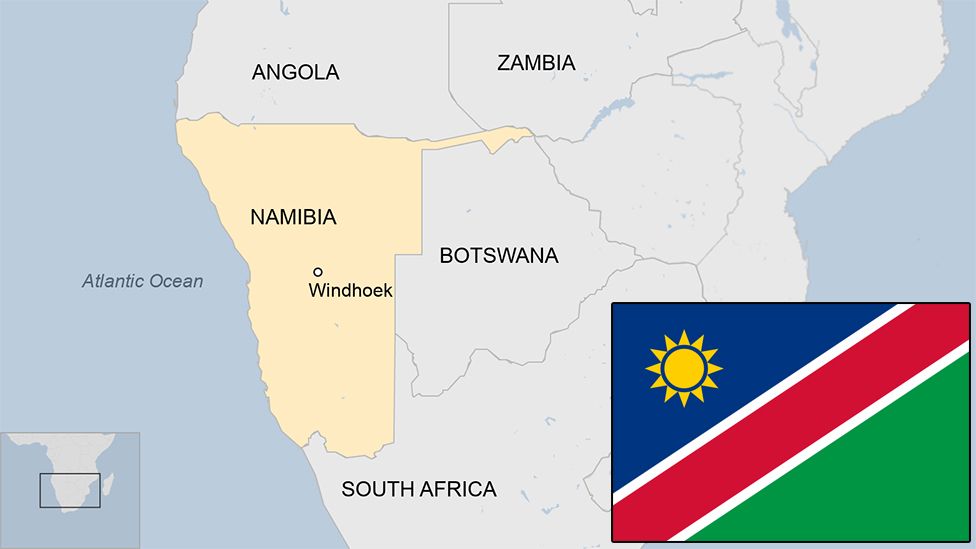Namibia country profile
- Published

Namibia, a large and sparsely populated country on Africa's south-west coast, has enjoyed stability since gaining independence in 1990 after a long struggle against rule by South Africa.
Germany took control of the area which it called South West Africa in the late 1800s.
The discovery of diamonds in 1908 prompted an influx of Europeans.
South Africa seized it during the First World War and administered it under a League of Nations mandate.
Namibia achieved independence in 1990 after a bush war of almost 25 years. Inter-racial reconciliation encouraged the country's white people to remain and they still play a major role in farming and other economic sectors.
- Read more country profiles - Profiles by BBC Monitoring
REPUBLIC OF NAMIBIA: FACTS
- Capital: Windhoek
- Area: 825,615 sq km
- Population: 2.5 million
- Languages: English, Afrikaans, German, Otjiherero, Khoekhoegowab, Oshiwambo, RuKwangali, Setswana, siLozi, !Kung, Gciriku, Thimbukushu
- Life expectancy: 59 years (men) 67 years (women)
LEADERS
President: Nangolo Mbumba
Vice-president Nangolo Mbumba took over as president in February 2024 following the death of his predecessor, Hage Geingob.
Hage Geingob, 82, was a veteran of the country's independence struggle. He had been diagnosed with cancer and had revealed the details to the public a month before his death.
Mr Mbumba said that Namibia had lost a "liberation... icon". He will serve as president until elections due later in 2024.
"I am not going to be around for the elections so don't panic," he said at the swiftly arranged swearing-in ceremony. Paying tribute to his predecessor, he said "our nation remains calm and stable owing to the leadership of President Geingob who was the chief architect of the constitution".
Mr Geingob first became president in 2015 but had served in top political positions since independence in 1990.
He chaired the constituent assembly that drafted the constitution which came into effect with Namibian independence from South Africa and he was independent Namibia's first prime minister.
Under the constitution, the president shares executive power with the cabinet and is limited to two five-year terms.
Prime minister: Saara Kuugongelwa-Amadhila
Saara Kuugongelwa-Amadhila was appointed prime minister in 2015, having served as finance minister for several years.
A longtime member of the ruling South West Africa People's Organization (SWAPO), she went into exile with the group to Sierra Leone at the age of 13.
After completing her economics degree in the United States, Ms Kuugongelwa-Amadhila returned to Namibia and worked briefly in the office of founding President Sam Nujoma, who quickly promoted her to head the National Planning Commission.
She then served as minister of finance from 2003 until her promotion to the position of prime minister by President Geingob.
MEDIA
Namibia is one of the more media-friendly countries in Africa.
Broadcasters and the private press give coverage to the opposition, including views critical of the government.
TIMELINE
Some key dates in Namibia's history:
Namibia has been inhabited since prehistoric times by the San, Damara, and Nama.
14th Century AD - Bantu people begin to arrive during the Bantu expansion from central Africa.
18th Century - Oorlam people from Cape Colony cross the Orange River and move into southern Namibia.
1878 - The British colony of the Cape of Good Hope annexes the port of Walvis Bay and the offshore Penguin Island, which become part of the new Union of South Africa in 1910.
1886-90 - Present international boundaries established by German treaties with Portugal and Britain. Germany annexes the territory as South West Africa.
1904-1907 - the Herero and Nama resist German colonialism. German forces brutally supress the uprising and systematically kill 10,000 Nama and some 65,000 Herero - in what is now acknowledged as genocide.
1915 - South Africa takes over territory during World War One.
1920 - League of Nations grants South Africa mandate to govern South West Africa (SWA).
1946 - South Africa refuses to place SWA under UN trusteeship.
1958 - Herman Toivo Ya Toivo and others create the opposition Ovamboland People's Congress, which becomes the South West Africa People's Organisation (Swapo) in 1960.
1961 - UN General Assembly demands South Africa terminate the mandate and sets SWA's independence as an objective..
1966 - South West Africa People's Organisation (Swapo) launches armed struggle against South African occupation.
1968 - South West Africa officially renamed Namibia by UN General Assembly.
1973 - UN General Assembly recognises Swapo as "sole legitimate representative" of Namibia's people.
1970s - Namibia became one of several flashpoints for Cold War proxy conflicts in southern Africa. The USSR and Cuba send military support to Swapo's armed wing, the People's Liberation Army of Namibia (PLAN).
1988 - Growing war weariness and the reduction of tensions between the superpowers compels South Africa, Angola and Cuba to accede to the Tripartite Accord. South Africa agrees to Namibian independence in exchange for removal of Cuban troops from Angola.
1990 - Namibia becomes independent, with Sam Nujoma as first president.
1994 - South African exclave of Walvis Bay turned over to Namibia.
1999 - Government quashes a secessionist attempt in the northeast Caprivi Strip by the rebel Caprivi Liberation Army.
2004 - Germany offers formal apology for its colonial-era mass-killings.
2005 - Namibia begins the expropriation of white-owned farms as part of a land-reform programme to resettle landless black Namibians.
2022 - Estimates suggest that two exploration wells in the offshore Orange Basin could hold two and three billion barrels of oil, respectively. The expected revenue could transform Namibia's economy.
- Published21 February 2023
- Published24 March 2023
- Published30 August 2023
- Published3 July 2023
- Published24 July 2023